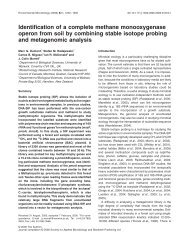Conservation of the vaquita Phocoena sinus - The Department of ...
Conservation of the vaquita Phocoena sinus - The Department of ...
Conservation of the vaquita Phocoena sinus - The Department of ...
You also want an ePaper? Increase the reach of your titles
YUMPU automatically turns print PDFs into web optimized ePapers that Google loves.
192 L. Rojas-Bracho, R. R. Reeves and A. Jaramillo-Legorreta<br />
above, populations <strong>of</strong> large sharks in <strong>the</strong> nor<strong>the</strong>rn Gulf have <strong>the</strong>mselves been subjected to<br />
heavy fishing pressure for more than half a century, and both landings (e.g. Table 3) and<br />
informal reports from fishermen suggest that <strong>the</strong>ir numbers have been seriously reduced.<br />
<strong>The</strong> question has been raised <strong>of</strong> whe<strong>the</strong>r trawling has deleterious direct or indirect effects<br />
on <strong>the</strong> prey base <strong>of</strong> <strong>vaquita</strong>s. A panel <strong>of</strong> experts (Norse et al., 2004) stated in an open letter<br />
tabled at <strong>the</strong> 2004 meeting <strong>of</strong> <strong>the</strong> International Committee for <strong>the</strong> Recovery <strong>of</strong> <strong>the</strong> Vaquita<br />
(CIRVA; see later) that ‘<strong>the</strong> overwhelming majority <strong>of</strong> scientific studies find that trawling<br />
causes significant effects on seafloor ecosystems [and] <strong>the</strong>re is . . . no reason to believe that<br />
<strong>the</strong> results would be any different in <strong>the</strong> Gulf <strong>of</strong> California . . .’. We are aware <strong>of</strong> only two<br />
studies dealing explicitly with <strong>the</strong> impacts <strong>of</strong> shrimp trawling in <strong>the</strong> nor<strong>the</strong>rn Gulf. <strong>The</strong> first<br />
(Nava Romo, 1994) concluded that trawling alters benthic-demersal communities by changing<br />
structure and reducing biodiversity. From <strong>the</strong> perspective <strong>of</strong> fisheries, it reduces <strong>the</strong><br />
captured biomass and mean weights <strong>of</strong> captured organisms. A different study (Pérez-Mellado<br />
& Findley, 1985) proposed that chronically trawled areas, such as <strong>the</strong> Upper Gulf, can suffer<br />
hypoxia (< 0.2 mL/L dissolved oxygen), including inclusive anoxia. This condition obviously<br />
would lessen <strong>the</strong> suitability <strong>of</strong> <strong>the</strong> sea floor as habitat for most benthic species.<br />
<strong>The</strong> net effect <strong>of</strong> trawling on <strong>vaquita</strong>s in <strong>the</strong> nor<strong>the</strong>rn Gulf is difficult to assess. Unquestionably,<br />
demersal trawling has physical impacts on <strong>the</strong> sea bottom, with associated effects<br />
on benthic communities wherever it is practised. <strong>The</strong>re is a worldwide scientific consensus<br />
that bottom trawls cause more damage to high-relief, structurally complex habitats than to<br />
even, s<strong>of</strong>t-bottom, sandy substrates such as those that dominate <strong>the</strong> nor<strong>the</strong>rn Gulf (MCBI,<br />
2002). <strong>The</strong> potential disturbance to <strong>vaquita</strong>s as <strong>the</strong>y respond to <strong>the</strong> approach <strong>of</strong> trawlers also<br />
needs to be considered. Particularly given <strong>the</strong> intensity <strong>of</strong> trawling and <strong>the</strong> extremely<br />
restricted distribution <strong>of</strong> <strong>vaquita</strong>s, such disturbance could have important effects on <strong>the</strong><br />
animals’ foraging, reproductive and aggregating behaviour (Jaramillo-Legorreta et al., 1999;<br />
Rojas-Bracho, Jaramillo-Legorreta & Gerrodette, 2002).<br />
O<strong>the</strong>r risk factors<br />
Consistent with <strong>the</strong> findings <strong>of</strong> various international panels that had reviewed <strong>the</strong> <strong>vaquita</strong>’s<br />
conservation status previously (e.g. IWC, 1991a,b,c, 1995, 1996; Vidal et al., 1999; see below),<br />
Rojas-Bracho & Taylor (1999) concluded that incidental mortality in fisheries was ‘<strong>the</strong><br />
greatest immediate risk for <strong>vaquita</strong>s’. In addition, <strong>the</strong>y identified and evaluated four o<strong>the</strong>r<br />
potential risk factors: (i) indirect effects <strong>of</strong> fishing on <strong>vaquita</strong> prey populations (see above);<br />
(ii) pollution by organochlorides, especially hydrocarbon pesticides used for agriculture in<br />
<strong>the</strong> Mexicali basin bordering <strong>the</strong> nor<strong>the</strong>rn Gulf and upstream in <strong>the</strong> Colorado River basin<br />
<strong>of</strong> <strong>the</strong> United States; (iii) habitat alteration caused by reduced flow from <strong>the</strong> Colorado River<br />
as a result <strong>of</strong> dam construction in <strong>the</strong> United States; and (iv) deleterious effects <strong>of</strong> inbreeding.<br />
<strong>The</strong>y summarized <strong>the</strong>ir conclusions regarding those potential risk factors as follows:<br />
<strong>The</strong> secondary effects <strong>of</strong> fishing in <strong>the</strong> Nor<strong>the</strong>rn Gulf, such as direct and indirect effects <strong>of</strong><br />
bycatch on prey species and alterations <strong>of</strong> <strong>the</strong> benthic habitat by repeated and intense<br />
trawling, are unknown and <strong>of</strong> concern. However, it is likely that any management actions<br />
taken to reduce direct kills <strong>of</strong> <strong>vaquita</strong>s by fishing activities will also affect <strong>the</strong>se potential<br />
indirect threats to <strong>the</strong> prey and habitat quality <strong>of</strong> <strong>vaquita</strong>s. Pollution appears not to be a risk.<br />
Reduction <strong>of</strong> <strong>the</strong> flow <strong>of</strong> <strong>the</strong> Colorado River does not appear to have sufficiently reduced<br />
current productivity to pose a short-term risk to <strong>vaquita</strong>s. Inbreeding is likely to be a factor<br />
in <strong>vaquita</strong> biology but <strong>the</strong>re is no evidence that inbreeding depression (causing a reduction<br />
in <strong>the</strong> population growth rate) should currently be a risk factor. <strong>The</strong>re is no basis for<br />
© 2006 <strong>The</strong> Authors. Issue compilation © 2006 Mammal Society, Mammal Review, 36, 179–216




